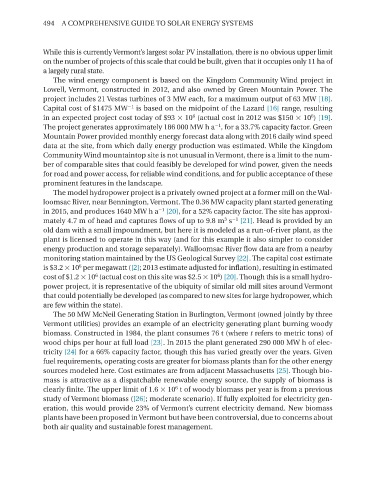Page 481 - A Comprehensive Guide to Solar Energy Systems
P. 481
494 A CoMPrEhEnsiVE GUidE To solAr EnErGy sysTEMs
While this is currently Vermont’s largest solar PV installation, there is no obvious upper limit
on the number of projects of this scale that could be built, given that it occupies only 11 ha of
a largely rural state.
The wind energy component is based on the Kingdom Community Wind project in
lowell, Vermont, constructed in 2012, and also owned by Green Mountain Power. The
project includes 21 Vestas turbines of 3 MW each, for a maximum output of 63 MW [18].
−1
Capital cost of $1475 MW is based on the midpoint of the lazard [16] range, resulting
6
6
in an expected project cost today of $93 × 10 (actual cost in 2012 was $150 × 10 ) [19].
−1
The project generates approximately 186 000 MW h a , for a 33.7% capacity factor. Green
Mountain Power provided monthly energy forecast data along with 2016 daily wind speed
data at the site, from which daily energy production was estimated. While the Kingdom
Community Wind mountaintop site is not unusual in Vermont, there is a limit to the num-
ber of comparable sites that could feasibly be developed for wind power, given the needs
for road and power access, for reliable wind conditions, and for public acceptance of these
prominent features in the landscape.
The model hydropower project is a privately owned project at a former mill on the Wal-
loomsac river, near Bennington, Vermont. The 0.36 MW capacity plant started generating
−1
in 2015, and produces 1640 MW h a [20], for a 52% capacity factor. The site has approxi-
−1
3
mately 4.7 m of head and captures flows of up to 9.8 m s [21]. head is provided by an
old dam with a small impoundment, but here it is modeled as a run-of-river plant, as the
plant is licensed to operate in this way (and for this example it also simpler to consider
energy production and storage separately). Walloomsac river flow data are from a nearby
monitoring station maintained by the Us Geological survey [22]. The capital cost estimate
6
is $3.2 × 10 per megawatt ([2]; 2013 estimate adjusted for inflation), resulting in estimated
6
6
cost of $1.2 × 10 (actual cost on this site was $2.5 × 10 ) [20]. Though this is a small hydro-
power project, it is representative of the ubiquity of similar old mill sites around Vermont
that could potentially be developed (as compared to new sites for large hydropower, which
are few within the state).
The 50 MW Mcneil Generating station in Burlington, Vermont (owned jointly by three
Vermont utilities) provides an example of an electricity generating plant burning woody
biomass. Constructed in 1984, the plant consumes 76 t (where t refers to metric tons) of
wood chips per hour at full load [23]. In 2015 the plant generated 290 000 MW h of elec-
tricity [24] for a 66% capacity factor, though this has varied greatly over the years. Given
fuel requirements, operating costs are greater for biomass plants than for the other energy
sources modeled here. Cost estimates are from adjacent Massachusetts [25]. Though bio-
mass is attractive as a dispatchable renewable energy source, the supply of biomass is
6
clearly finite. The upper limit of 1.6 × 10 t of woody biomass per year is from a previous
study of Vermont biomass ([26]; moderate scenario). if fully exploited for electricity gen-
eration, this would provide 23% of Vermont’s current electricity demand. new biomass
plants have been proposed in Vermont but have been controversial, due to concerns about
both air quality and sustainable forest management.

